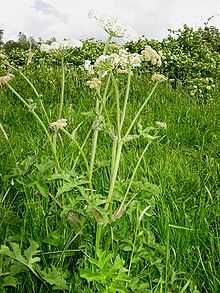Heracleum sphondylium
| Heracleum sphondylium | |
|---|---|
 | |
| Scientific classification | |
| Kingdom: | Plantae |
| (unranked): | Angiosperms |
| (unranked): | Eudicots |
| (unranked): | Asterids |
| Order: | Apiales |
| Family: | Apiaceae |
| Genus: | Heracleum |
| Species: | H. sphondylium |
| Binomial name | |
| Heracleum sphondylium L. | |
| Synonyms | |
| |
Heracleum sphondylium, common names hogweed or common hogweed, is a herbaceous perennial or biennial plant of the family Apiaceae, native to Europe and Asia. It is an umbelliferous plant, in the same group as fennel, cow parsley, ground elder and giant hogweed. Umbelliferous plants are so named because of the umbrella-like arrangement of flowers they produce. The North American species Heracleum maximum (cow parsnip) is sometimes included as a subspecies of H. spondylium.
Etymology
The genus name Heracleum derives from the Greek "herákleion" and refers to the mythologic hero Heracles, while the species name sphondylium, meaning "vertebrae", refers to the shape of the segmented stem.
Description

This plant has pinkish or white flowers with 5 petals. They are arranged in large umbels of up to 20 cm of diameter with 15 to 30 rays. The peripheral flowers have a radial symmetry. Flowering typically occurs between June and October. The flowers are pollinated by insects (usually bees, wasps and flies) (entomogamy) The small fruits are flattened and winged, elliptical to rounded and glabrous, up to 1 cm long. The seed dispersal is by wind (anemochory).
The characteristic pig-like smell of the inflorescence gives it its name.
Heracleum sphondylium is smaller in size than the skin irritating Heracleum mantegazzianum (Giant Hogweed).
The small picture-winged fly Euleia heraclei is as its name suggests found on Hogweed.[1]
Distribution
These plants have a Eurasian distribution, growing all over Europe (except Iceland), and North Africa.
Habitat
The plant is common in herbaceous places, along roads, in hedges, meadows and woods, especially in mountain areas up to 2500 m of altitude. It prefers moist, nitrogen-rich soils.
Similar species
The water parsnip (swamp parsnip, Sium suave), western water hemlock (Cicuta douglasii, poison hemlock) and spotted water hemlock (Cicuta maculata, spotted parsley, spotted cowbane) all have white flowers in large compound umbels, which can lead to misidentification. All water hemlock and poison hemlock are highly poisonous,[2] but water parsnip is not.[3] Both have clusters of small white flowers shaped like umbrellas, and have the same habitat near the shore line of lakes and rivers. Water parsnip has leaves only once compound, and water hemlock has leaves which are three times compound. Water hemlock has a large swelling at the stem base, and has bracts at the base of each small flower cluster, not at the base of the main flower head.[4] The Water parsnip has small bracts at the base of flowers and main flower head as well.[5] Yarrow from the Asteraceae family (Achillea millefolium) also has many small white flowers in a cluster. However the yarrow has feathery looking leaves which are pinnately separated into small narrow segments.[6] The cow parsnips (Heracleum lanatum, Heracleum maximum) are also confused in this group with similar flower groupings. However, the cow parsnips have large, broad leaves, and an unpleasant odour.[7]
Subspecies
This species presents a large variability of the characteristics and the occurrence of many intermediate forms. In Europe there are eight named subspecies.
- Heracleum sphondylium subsp. chloranthum (Borbás) Neumayer
- Heracleum sphondylium subsp. elegans (Crantz) Schübl. & G. Martens
- Heracleum sphondylium subsp. glabrum (Huth) Holub
- Heracleum sphondylium subsp. orsinii (Guss.) H. Neumayer
- Heracleum sphondylium subsp. pyrenaicum (Lam.) Bonnier & Layens
- Heracleum sphondylium subsp. sibiricum (L.) Simonk.
- Heracleum sphondylium subsp. sphondylium
- Heracleum sphondylium subsp. trachycarpum (Soják) Holub
References
| Wikispecies has information related to: Heracleum sphondylium |
| Wikimedia Commons has media related to Common Hogweed. |
- ↑ Euleia heraclei Retrieved 18 May 2012
- ↑ "Cicuta maculata.". Retrieved 2008-08-03.
- ↑ Kuhnlein, Harriet V; Turner, Nancy J. (1991). Traditional Plant Foods of Canadian Indigenous Peoples. Taylor & Francis. ISBN 978-2-88124-465-0. Retrieved 2008-08-03.
- ↑ "Western Water Hemlock - Agriculture - Government of Saskatchewan". Retrieved 2008-08-03.
- ↑ "Water Parsnip - Agriculture - Government of Saskatchewan". Retrieved 2008-08-03.
- ↑ "Yarrow Achillea millefolium". Retrieved 2008-08-03.
- ↑ "Heracleum lanatum". University of Saskatchewan. Retrieved 2008-08-03.
- Pignatti S. - Flora d'Italia – Edagricole – 1982, Vol. II, pag. 237
- Tutin, T. G. & al. (ed.) (1968). Flora Europaea. (vol.2) Cambridge University Press, Cambridge. [p.365]